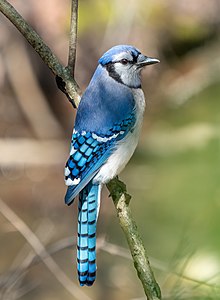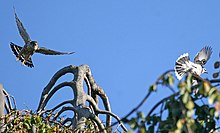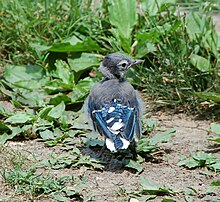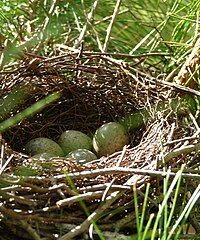Blue jay
| Blue jay Temporal range: Piacenzian - present
| |
|---|---|

| |
| In Prospect Park, Brooklyn , New York
| |
| Scientific classification | |
| Domain: | Eukaryota |
| Kingdom: | Animalia |
| Phylum: | Chordata |
| Class: | Aves |
| Order: | Passeriformes |
| Family: | Corvidae |
| Genus: | Cyanocitta |
| Species: | C. cristata
|
| Binomial name | |
| Cyanocitta cristata | |
| Subspecies | |
|
4 sspp., see text | |

| |
| Approximate distribution map
Year-round
Nonbreeding
| |
| Synonyms | |
|
Corvus cristatus Linnaeus, 1758 | |
The blue jay (Cyanocitta cristata) is a
The blue jay feeds mainly on seeds and nuts, such as
It builds an open cup nest in the branches of a tree; both sexes participate. The clutch may be two to seven eggs, which are blueish or light brown with darker brown spots. Young are
The name jay derives from the bird's noisy, garrulous nature and has been applied to other birds of the same family, which are also mostly gregarious.[4] Jays are also called jaybirds.[5]
Taxonomy
The blue jay was first described as Pica glandaria cærulea cristata in
Description

The blue jay measures 22–30 cm (9–12 in) from bill to tail and weighs 70–100 g (2.5–3.5 oz), with a wingspan of 34–43 cm (13–17 in).[11][12] Consistent with Bergmann's rule, jays from Connecticut averaged 92.4 g (3.26 oz) in mass, while jays from warmer southern Florida averaged 73.7 g (2.60 oz).[13][14] There is a pronounced crest on the head, a crown of feathers, which may be raised or lowered according to the bird's mood. When excited or aggressive, the crest will be fully raised. When frightened, the crest bristles outwards, brushlike. When the bird is feeding among other jays or resting, the crest is flattened on the head.[15]
Its plumage is lavender-blue to mid-blue in the crest, back, wings, and tail, and its face is white. The underside is off-white and the neck is collared with black which extends to the sides of the head. The
As with most other blue-hued birds, the blue jay's coloration is not derived from
Distribution and habitat
The blue jay occurs from southern Canada (including the southern areas of provinces from Alberta eastward to Quebec and throughout the Atlantic provinces) and throughout the eastern and central United States south to
The northernmost subspecies C. c. bromia is migratory, subject to necessity. It may withdraw several hundred kilometers south in the northernmost parts of its range. Thousands of blue jays have been observed to migrate in flocks along the Great Lakes and Atlantic coasts. It migrates during the daytime, in loose flocks of 5 to 250 birds. Much about their migratory behavior remains a mystery. Some are present throughout winter in all parts of their range. Young jays may be more likely to migrate than adults, but many adults also migrate. Some individual jays migrate south one year, stay north the next winter, and then migrate south again the next year. To date, no one has concretely worked out why they migrate when they do. Likely, it is related to weather conditions and how abundant the winter food sources are, which can determine whether other northern birds will move south.[25]
The blue jay occupies a variety of habitats within its large range, from the pine woods of Florida to the spruce-fir forests of northern Ontario. It is less abundant in denser forests, preferring mixed woodlands with oaks and beeches.[15] It has expertly adapted to human activity, occurring in parks and residential areas, and can adapt to wholesale deforestation with relative ease if human activity creates other means for the jays to get by.[26]
Subspecies
Four
| Image | Subspecies | Common Name | Description | Distribution |
|---|---|---|---|---|
 |
Cyanocitta cristata bromia Oberholser, HC 1921 | Northern blue jay | The largest subspecies, with fairly dull plumage. Blue is rather pale. | Canada and northern United States. |
 |
Cyanocitta cristata cristata | Coastal blue jay | The nominate subspecies, mid-sized and vivid blue. | Coastal USA from North Carolina to Texas, except southern Florida |
 |
Cyanocitta cristata cyanotephra Sutton, GM 1935 | Interior blue jay | Mid-sized, quite dark blue on mantle contrasting cleanly with very white underside. | Inland USA from SE Wyoming and Nebraska to west Kansas, Oklahoma and northern Texas, intergrading with C. c. bromia to the north. |
 |
Cyanocitta cristata semplei Todd, 1928 | Florida blue jay | The smallest subspecies, much like C. c. bromia in color. | Southern Florida. |
Behavior

The blue jay is a noisy, bold, and aggressive passerine. It is a moderately slow flier (roughly 32–40 km/h or 20–25 mph) when unprovoked.[27] It flies with body and tail held level, with slow wing beats. Its slow flying speeds make this species easy prey for hawks and owls when it flies in open areas. Virtually all the raptorial birds sympatric in distribution with the blue jay may prey upon it, especially swift bird-hunting specialists such as the Accipiter hawks. Diverse predators may prey on jay eggs and young up to their fledgling stage, including tree squirrels, snakes, cats, crows, raccoons, opossums, other jays and possibly many of the same birds of prey who attack adults.[28]
The blue jay can be beneficial to other bird species, as it may chase
When a blue jay is agitated or angry, the blue crest atop its head will rise. It will lower when the bird is relaxed or calm.[31]

Blue jays, like other corvids, are highly curious and are considered intelligent birds. Young individuals playfully snatch brightly coloured or reflective objects, such as bottle caps or pieces of aluminum foil, and carry them around until they lose interest.[29] While not confirmed to have engaged in tool use in the wild, blue jays in captivity have been observed using strips of newspaper as tools to obtain food,[25][32] while captive fledglings have been observed attempting to open the doors of their cages.[33]
Diet
Blue jays are omnivorous, but the
Reproduction
The mating season begins in mid-March, peaks in mid-April to May, and extends into July. Any suitable tree or large bush may be used for nesting, though an evergreen is preferred. The nest is preferentially built at a height in the trees of 3 to 10 m (10 to 33 ft). It is cup-shaped and composed of twigs, small roots, bark strips, moss, other plant material, cloth, paper, and feathers, with occasional mud added to the cup.

Blue jays are not very picky about nesting locations. If no better place is available – such as in a heavily deforested area – they will even use places like the large mailboxes typical of the rural United States.[26] They also appropriate nests of other mid-sized songbirds as long as these are placed in suitable spots; American robin nests are commonly used by blue jays, for example.

Blue jays typically form
After the juveniles fledge, the family travels and forages together until early fall, when the young birds disperse to avoid competition for food during the winter. Sexual maturity is reached after one year of age. The oldest known wild, banded Blue Jay was at least 26 years, 11 months old when it was found dead after being caught in fishing gear. It had been banded in the Newfoundland/Labrador/Saint-Pierre et Miquelon area in 1989 and was found there in 2016.[37] Another wild jay was found to have been around 17+1⁄2 years old.[38] A more common lifespan for wild birds that survive to adulthood is around 7 years.[39] Beyond predation and the occasional collision with man-made objects, a common cause of mortality in recent decades has been the West Nile virus, to which corvids as a whole seem especially susceptible. However, despite several major local declines, overall blue jays have not seemed to have been depleted by the disease.[28]
Vocalizations
Blue jays can make a large variety of sounds, and individuals may vary perceptibly in their calling style. Like other corvids, they may learn to mimic human speech. Blue jays can also copy the cries of local hawks so well that it is sometimes difficult to tell which it is.
Blue jays also have quiet, less noticeable calls which they use among themselves in proximity. One of the most distinctive calls of this type is often referred to as the "rusty pump" owing to its squeaky resemblance to the sound of an old hand-operated
In human culture
In old African-American folktales of the southern United States, the blue jay was a significant metaphysical creature. In some tales, the blue jay was credited with making the earth "when all de worl' was water" by bringing the first "grit" or "dirt." In other tales the blue jay was temporarily conscripted as a servant of the devil and would not be seen on Friday as it was gathering twigs to furnish hell's kindling and give fire to wicked men on Earth; relieved from duty on Saturday, its song for the day was abundant and joyous.[41][42]
The blue jay was adopted as the team symbol of the Toronto Blue Jays Major League Baseball team, as well as some of their minor league affiliates. Their mascot, Ace, is an anthropomorphic blue jay. The blue jay is also the official mascot for Johns Hopkins University, Elmhurst University, and Creighton University. It is also the provincial bird of the province of Prince Edward Island in Canada.[43]
References
- . Retrieved 25 June 2022.
- ^ "The blue jays are coming! Hide yo kids, hide yo nuts!". Seriously, Science?.
- ^ Little Known Fact: Blue Jays are Vicious Carnivores. pedaldrivenprogramming.com (15 Apr 2008)
- OCLC 469020022.
- ^ "jaybird – definition of jaybird by the Free Online Dictionary, Thesaurus and Encyclopedia". Retrieved April 20, 2011.
- ^ Catesby, Mark (1731). Natural History of Carolina, Florida, and the Bahamas (1st ed.). London: Royal Society House. p. 87.
- ^ Linnaeus, C. (1758). Systema Naturae per Regna Tria Naturae, Secundum Classes, Ordines, Genera, Species, cum Characteribus, Differentiis, Synonymis, Locis. Tomus I. Editio Decima, Reformata (in Latin). Vol. 1. Holmiae: Laurentius Salvius. p. 106.
- ^ Bonaparte, Charles L. (1838). A geographical and comparative list of the birds of Europe and North America. London: J. Van Voorst. p. 27.
- ^ Bulletin of the National History Survey, Issues 4-6. Chicago: Chicago Academy of Sciences. 1900. p. 120.
- ISBN 978-1609382254.
- ^ a b c Blue Jay, Life History, All About Birds. Cornell Lab of Ornithology
- ^ a b c "ADW: Cyanocitta cristata: INFORMATION". Animal Diversity Web.
- ^ Jewell, S. D. (1986). "Weights and wing lengths in Connecticut Blue Jays". Connecticut Warbler. 6 (4): 47–49.
- JSTOR 4512458.
- ^ a b "Blue Jay". Canadian Wildlife Service. Archived from the original on 2009-02-04. Retrieved 2009-08-09.
- ^ ISBN 978-0-7136-3999-5.
- ^ Carpenter, Anita (February 2003). "What Color is a Bluejay?". Wisconsin Natural Resources Magazine. Archived from the original on 2018-07-31. Retrieved 2012-10-21.
- .
- JSTOR 4512360.
- ^ Tarvin KA, Woolfenden GE. (1999). "Blue Jay (Cyanocitta cristata)", no. 469. In: A. Poole (ed.). The Birds of North America Online. Cornell Lab of Ornithology, Ithaca, New York.
- S2CID 86276981.
- S2CID 84426970.
- S2CID 85425945.
- ^ "Blue Jay Cyanocitta cristata BBS Trend Map, 1966 - 2015". USGS. U.S. Department of the Interior. Retrieved 2020-12-09.
- ^ a b c d e f Blue Jay. birds.cornell.edu
- ^ Wilson Bulletin. 18 (2): 47–60.
- ^ Animal Speeds. Texas Parks & Wildlife. Retrieved July 1, 2008.
- ^ a b "ADW: Cyanocitta cristata: INFORMATION". Animal Diversity Web.
- ^ a b c "Blue Jay". Archived from the original on 2007-05-02.
- JSTOR 4082327.
- ^ "The Truth About Blue Jays – The Free Weekly". Retrieved 2019-09-08.
- S2CID 22011846.
- ^ American Rivers Archived 2013-12-18 at the Wayback Machine. tumblr.com
- ^ "Blue Jay Cyanocitta cristata". Audubon.org. 13 November 2014.
- ^ "Blue jays love peanuts in the shell".
- ^ AllAboutBirds.org – Blue Jay The Cornell Lab of Ornithology
- ^ "Blue Jay Overview, All About Birds, Cornell Lab of Ornithology".
- ^ "Longevity Records Of North American Birds". U. S. Geological Survey: Bird Banding Laboratory. Retrieved 24 December 2012.
- ^ "Animal facts: Blue Jay". Canadian Geographic. The Royal Canadian Geographical Society. July 26, 2006. Archived from the original on February 4, 2019. Retrieved February 3, 2019.
- ISBN 978-0-7922-3373-2
- ^ Ingersoll, Ernest (1923). Birds in legend, fable and folklore. New York: Longmans, Green and Co. pp. 166–167. Retrieved 2009-08-08.
- ISBN 978-0-486-12296-0.
- ^ "Provincial Bird". Prince Edward Island. 26 May 2015. Retrieved 1 February 2024.
External links
 Data related to Cyanocitta cristata at Wikispecies
Data related to Cyanocitta cristata at Wikispecies- Blue Jay ID, including sound and video, at Cornell Lab of Ornithology
- Blue Jay – Cyanocitta cristata – USGS Patuxent Bird Identification InfoCenter archived May 2010
- "Blue Jay media". Internet Bird Collection.
- Blue Jay at borealforest.org archived May 2021
- Blue Jay Bird Sound at Florida Museum of Natural History archived January 2011
- Photo essay of blue jay nestlings archived April 2014
- Blue Jay photo gallery at VIREO (Drexel University)




